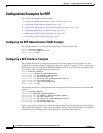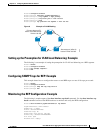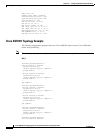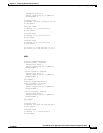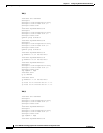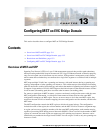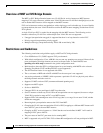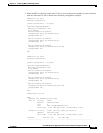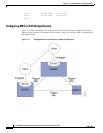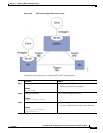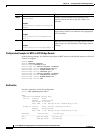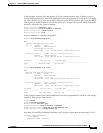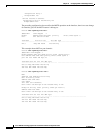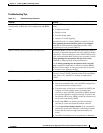
13-2
Cisco ASR 901 Series Aggregation Services Router Software Configuration Guide
OL-23826-09
Chapter 13 Configuring MST on EVC Bridge Domain
Contents
Overview of MST on EVC Bridge Domain
The MST on EVC Bridge-Domain feature uses VLAN IDs for service-instance-to-MST-instance
mapping. EVC service instances with the same VLAN ID (the outer VLAN IDs in the QinQ case) as the
one in another MST instance will be mapped to that MST instance.
EVC service instances can have encapsulations with a single tag as well as double tags. In case of double
tag encapsulations, the outer VLAN ID shall be used for the MST instance mapping, and the inner VLAN
ID is ignored.
A single VLAN per EVC is needed for the mapping with the MST instance. The following service
instances without any VLAN ID or with multiple outer VLAN IDs are not supported:
• Untagged (encapsulation untagged) is supported but there is no loop detection on the EVC
• Priority-tagged (encapsulation priority-tagged)
• Multiple outer tags (encapsulation dot1q 200 to 400 second-dot1q 300)
Restrictions and Guidelines
The following restrictions and guidelines apply to MST on EVC bridge domain:
• Cisco IOS Release 15.1(2)SNG supports EVC port-channels.
• With default configuration, Cisco ASR 901 does not run any spanning-tree protocol. Hence all the
ports participating in bridge domains are moved to forward state. To enable MSTP, issue
spanning-tree mode mstp command in the global configuration mode.
• Main interface where the EFP is configured must be up and running with MSTP as the selected
Spanning Tree Mode (PVST and Rapid-PVST are not supported).
• The SPT PortFast feature is not supported with EFPs.
• The co-existence of REP and mLACP with MST on the same port is not supported.
• Any action performed on VPORT (which represents a particular VLAN in a physical port) affects
the bridge domain and other services.
• Supports 32 MSTs and one CIST (common and internal spanning tree).
• Supports one MST region.
• Scales to 4000 EFPs.
• Untagged EVCs do not participate in MST loop detection.
• Service instances without any VLAN ID in the encapsulation are not supported, because a unique
VLAN ID is required to map an EVC to an MST instance.
• Supports EFPs with unambiguous outer VLAN tag (that is, no range, list on outer VLAN, neither
default nor untagged).
• Removing dot1q encapsulation removes the EVC from MST.
• Changing the VLAN (outer encapsulation VLAN of EVC) mapping to a different MST instance will
move the EVC port to the new MST instance.
• Changing an EVC service instance to a VLAN that has not been defined in MST 1 will result in
mapping of EVC port to MST 0.
• The peer router of the EVC port must also be running MST.
• MST is supported only on EVC BD. EVCs without BD configuration will not participate in MST.



